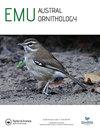Morphometric analysis confirms the presence of the Plains-wanderer (Aves: Pedionomus torquatus) in fossil deposits at Naracoorte Caves, South Australia
IF 1.1
4区 生物学
Q3 ORNITHOLOGY
引用次数: 0
Abstract
ABSTRACT The Plains-wanderer (Pedionomidae: Pedionomus torquatus) is a species of Australian shorebird that exclusively inhabits open grasslands. The reported presence of this species in the fossil deposits of Naracoorte Caves suggests that it once inhabited a wooded environment. It was therefore important to assess whether the fossils are indeed conspecific with P. torquatus before inferences on the past palaeoecological preferences of the species are made. This study reassessed the identity of fossils identified as P. torquatus using both qualitative observations and morphometric analyses to test for proportional differences of fossil specimens which might indicate taxonomic distinction. Measurements were collected from fossils attributed to Pedionomus from Blanche Cave (45–15 ka) and Victoria Fossil Cave (>400–220 ka), and compared with modern skeletal specimens through univariate and principal component analyses. Fossil elements were significantly larger than the modern specimens, although marked overlap was consistently observed, precluding unambiguous differentiation on size. No qualitative traits distinguishing the two groups could be identified. The Naracoorte fossil Pedionomus are therefore considered to represent a population of P. torquatus, wherein birds were slightly larger than extant ones. The Naracoorte deposits sampled a forest and woodland-dominated environment over the last 400,000 years, one which would be deemed unsuitable for modern Plains-wanderers, indicating that P. torquatus may have formerly occupied a much broader range of habitats than its present distribution suggests. It is inferred that the Plains-wanderer underwent a marked contraction in occupied habitat during the Holocene.形态计量学分析证实了在南澳大利亚Naracoorte洞穴的化石沉积物中存在平原漫游者(鸟类:Pedionomus torquatus)
本文章由计算机程序翻译,如有差异,请以英文原文为准。
求助全文
约1分钟内获得全文
求助全文
来源期刊

Emu-Austral Ornithology
生物-鸟类学
CiteScore
2.00
自引率
7.70%
发文量
33
审稿时长
>12 weeks
期刊介绍:
Emu – Austral Ornithology is the premier journal for ornithological research and reviews related to the Southern Hemisphere and adjacent tropics. The journal has a long and proud tradition of publishing articles on many aspects of the biology of birds, particularly their conservation and management.
 求助内容:
求助内容: 应助结果提醒方式:
应助结果提醒方式:


